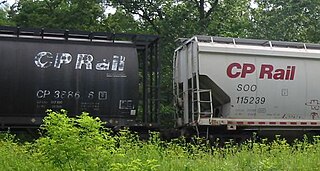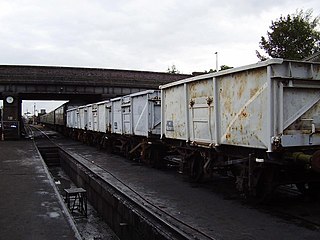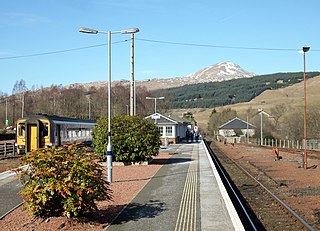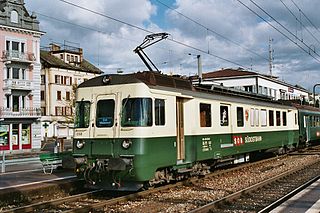
A railroad car, railcar, railway wagon, railway carriage, railway truck, railwagon, railcarriage or railtruck, also called a train car, train wagon, train carriage or train truck, is a vehicle used for the carrying of cargo or passengers on a rail transport network. Such cars, when coupled together and hauled by one or more locomotives, form a train. Alternatively, some passenger cars are self-propelled in which case they may be either single railcars or make up multiple units.
Rail transport terms are a form of technical terminology applied to railways. Although many terms are uniform across different nations and companies, they are by no means universal, with differences often originating from parallel development of rail transport systems in different parts of the world, and in the national origins of the engineers and managers who built the inaugural rail infrastructure. An example is the term railroad, used in North America, and railway, generally used in English-speaking countries outside North America and by the International Union of Railways. In English-speaking countries outside the United Kingdom, a mixture of US and UK terms may exist.

The International Union of Railways is an international rail transport industry body.

Metro-Cammell, formally the Metropolitan Cammell Carriage and Wagon Company (MCCW), was an English manufacturer of railway carriages, locomotives and railway wagons, based in Saltley, and subsequently Washwood Heath, in Birmingham. The company was purchased by GEC Alsthom in May 1989; the Washwood Heath factory closed in 2005 and was demolished in early 2019.

A reporting mark is a code used to identify owners or lessees of rolling stock and other equipment used on certain rail transport networks. The code typically reflects the name or identifying number of the owner, lessee, or operator of the equipment. Similar to IATA airline designators.
A number of different numbering and classification schemes have been used for carriages and wagons on Britain's railways, and this page explains the principal systems. Carriages and wagons have frequently had similar arrangements for classification and numbering, so are considered together. There are also links to other pages that deal in greater depth with the particulars of individual types.

A siding, in rail terminology, is a low-speed track section distinct from a running line or through route such as a main line, branch line, or spur. It may connect to through track or to other sidings at either end. Sidings often have lighter rails, meant for lower speed or less heavy traffic, and few, if any, signals. Sidings connected at both ends to a running line are commonly known as loops; those not so connected may be referred to as single-ended or dead-end sidings, or stubs.

The British Rail Class 46 is a class of diesel locomotive. They were built from 1961 to 1963 at British Railways' Derby Works and were initially numbered D138–D193. With the arrival of TOPS they were renumbered to Class 46. Along with the similar Class 44 and 45 locomotives, they became known as Peaks.

A mineral wagon or coal truck is a small open-topped railway goods wagon used in the United Kingdom and elsewhere to carry coal, ores and other mine products.
This article contains a list of jargon used to varying degrees by railway enthusiasts, trainspotters, and railway employees in the United Kingdom, including nicknames for various locomotives and multiple units. Although not exhaustive, many of the entries in this list appear from time to time in specialist, rail-related publications. There may be significant regional variation in usage.

A merry-go-round train, often abbreviated to MGR, is a block train of hopper wagons which both loads and unloads its cargo while moving. In the United Kingdom, they are most commonly coal trains delivering to power stations. These trains were introduced in the 1960s, and were one of the few innovations of the Beeching cuts, along with investment from the Central Electricity Generating Board (CEGB) and the NCB into new power stations and loading facilities.

Crianlarich railway station is a railway station serving the village of Crianlarich in Scotland. It is located on the West Highland Line, sited 41 miles 25 chains (66.5 km) from Craigendoran Junction, near Helensburgh, with Ardlui to the south, and Tyndrum Lower and Upper Tyndrum to the north west, on the routes to Oban and Mallaig respectively, which diverge immediately north of the station. ScotRail, who manage the station, operate most services.

A mixed train or mixed consist is a train that contains both passenger and freight cars or wagons. Although common in the early days of railways, by the 20th century they were largely confined to branch lines with little traffic. Typically, service was slower, because mixed trains usually involved the shunting (switching) of rolling stock at stops along the way. However, some earlier passenger expresses, which also hauled time-sensitive freight in covered goods wagons (boxcars), would now be termed mixed trains. Generally, toward the end of the mixed train era, shunting at intermediate stops had significantly diminished. Most railway passenger and freight services are now administered separately.

A motor coach or motorcar is a self-propelled passenger rail vehicle also capable of hauling a train. With multiple unit train control, one operator can control several "motor coaches", possibly even combined with locomotives, efficiently in the same train, making longer trains possible.

The fleet of Great Western Railway wagons was both large and varied as it carried the wide variety of goods traffic on the Great Western Railway (GWR) in the United Kingdom. This was the railway company that operated for the longest period of time in the country and covered a large geographical area that included big cities such as London, industrialised areas including the West Midlands, areas of coal and mineral mining such as South Wales, and Somerset and other important agricultural districts. In 1902 the company owned 59,036 wagons, and by 1926 this had risen to 88,580.

North Dorset Railway is a heritage railway based at Shillingstone railway station on the former Somerset and Dorset Joint Railway in the United Kingdom.
Departmental vehicles, also called departmental wagons or engineering vehicles, are special railway vehicles used to support the engineering functions of the railway. Thus they serve the internal purposes of the railway company and are not used for general passenger or goods traffic. They are typically used to maintain railway facilities, not least the overhead catenary.

A bogie bolster wagon is a British railway term for a wagon designed to carry long thin cargoes such as timber or rails and other steel sections. The sides and ends are minimal and there is no roof. The load is carried longitudinally and borne by three or more bolsters fixed transversely. The load is constrained sideways by movable metal stanchions fitted into the ends of the bolsters, and secured with chains and shackles.

Basford Hall Yard is a railway marshalling yard near the town of Crewe, Cheshire, England. The yard, which is 0.93 miles (1.5 km) south of Crewe railway station, was opened in 1901 by the London and North Western Railway (LNWR). Initially used to marshal trains, the site now acts as a hub mainly for Freightliner intermodal trains, but also houses departmental sidings as used by Freightliner Heavy Haul, and other operators. For a period in the 1930s, Basford Hall was the busiest marshalling yard in Europe, handling between 28,000 and 47,000 wagons every week.

Presflo and Prestwin were the designation for two types of goods wagon designed by British Railways in the 1950s for the carriage of powdered goods. The Presflo design was specifically for carriage of powdered cement but wagons to this design were subsequently used to transport other powdered commodities. The later Prestwin wagons were designed to overcome problems encountered with using the Presflo design for certain powdered commodities. Both types of wagon were loaded by gravity but unloaded using compressed air.



































